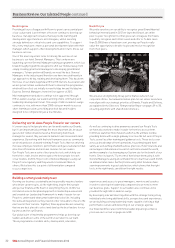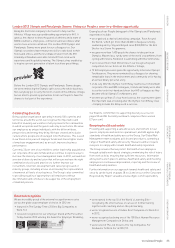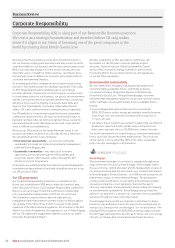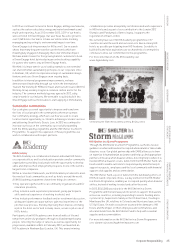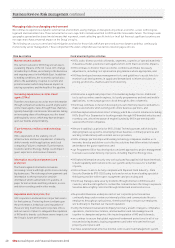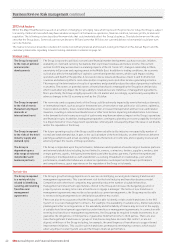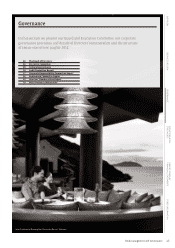Holiday Inn 2012 Annual Report Download - page 41
Download and view the complete annual report
Please find page 41 of the 2012 Holiday Inn annual report below. You can navigate through the pages in the report by either clicking on the pages listed below, or by using the keyword search tool below to find specific information within the annual report.
Risk management 39
Risk Management Framework
The Risk Management Framework is depicted in the ‘Manage Risk’ cog of the Hotel Safety Framework shown on page 41. This is a pragmatic
risk framework which starts with a risk profile and moves through the necessary considerations for effective management or mitigation of
risks. The framework reflects the cyclical nature of risks and allows for continuous assessment, particularly as the operating environment
and competitive landscape is in a constant state of change. The segments of the ‘Manage Risk’ cog are as follows:
Robust risk management process and framework
The Major Risk Review process enables the business to identify, monitor and manage the most significant risks to the Group (the Major Risks)
and report these to the senior leadership teams across the regions and corporate functions. The Risk Management Framework provides a
systematic consistent approach to managing identified risks.
Major Risk Review process
Having in place a robust major risk review process is essential to
maintaining an effective risk management system. IHG’s Major Risk
Review process continuously identifies, monitors and manages risks
owned by a wide range of stakeholders across each region, major
projects and the corporate functions.
The Board is ultimately responsible for the Group’s strategy and
system of internal controls and risk management, as explained
on pages 54 and 55. In addition, the Audit Committee annually
reviews the effectiveness of the Group’s internal controls and risk
management system.
Risks identified in the regions, functions and projects are consolidated,
refined and calibrated against a strategic view of risks by the
Risk Working Group (RWG). The RWG is chaired by the General
Counsel and Company Secretary and comprises the Heads of Global
Strategy, Programme Office, Global Risk Management and Global
Internal Audit and takes an active role in overseeing the Major Risks.
The RWG meets on a quarterly basis, to ensure the Major Risks are
appropriately managed and emerging risks are identified. The Major
Risks are then discussed with the Executive Committee to gain
agreement on the risk descriptions and ownership of actions, before
final presentation to the Audit Committee and the Board.
Risk profile: the identification and prioritisation of risks against
consistently applied assessment definitions. This includes an
assessment of gross risk (the level of risk before controls or actions
are taken) and net risk (the level of risk after existing management
actions are applied). Where these management actions are not
sufficient, a further target risk level is set. The risk profile is captured
in ‘heatmaps’ as shown in the diagram below:
Policy and standards: the formal articulation of the approach,
controls and actions for IHG employees when dealing with specific
risks. These set out accountability for risks, relevant roles and
responsibilities and actions that are measurable or auditable;
Ways of working: the practical aspects of risk management, such
as roles, tools, templates, systems, forums and behaviours, which
help management bring the policies and standards to life;
Training and communication: the face-to-face and online learning
programmes to provide appropriate skills and knowledge and
regular communication to raise awareness;
Operate and control: the ongoing operational activities and the
use of tools, systems, checks and control measures to support
compliance with policies and standards and to manage risk;
Risk financing: the consideration of the financial impact of risks if
they were to happen and ensuring, where possible, that appropriate
coverage is in place, which is usually through insurance; and
Review and report: the collection and analysis of management
information to evaluate the effectiveness of controls and risk
management, changes in the risk environment and delivery
of action plans.
Risk Working Group (RWG)
IHG Risk Profile
Risk Profiles in Regions, Functions and Projects
Executive Committee
BoardAudit Committee
N
T
Impact
G
Likelihood
G
Gross Risk
(Risk level with ineffective
or no controls in place)
N
Net Risk
(Current risk level with
existing controls in place)
T
Target Risk
(Desired risk level to optimise
investment, as required)
OVERVIEW BUSINESS REVIEW GOVERNANCE
GROUP FINANCIAL
STATEMENTS
PARENT COMPANY
FINANCIAL STATEMENTS OTHER INFORMATION





